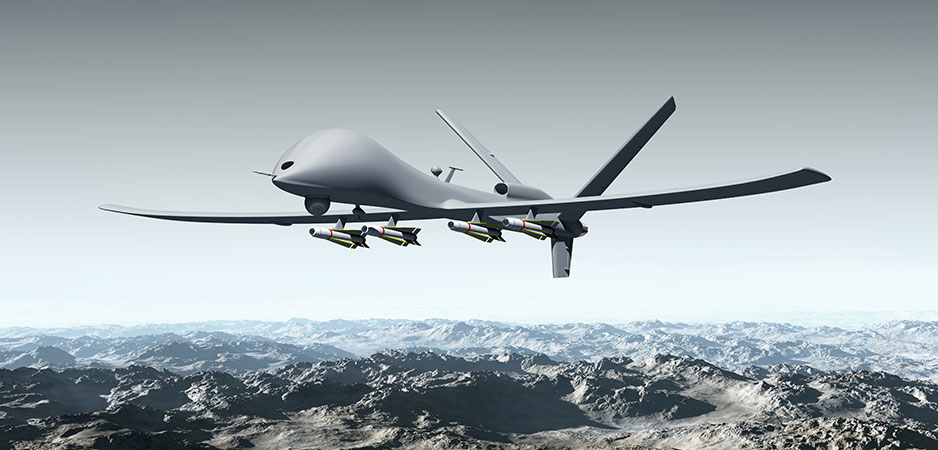
By Ahyousha Khan 31 December 2021
Although drones considered as a modern day technology but their history can be traced in World War I and II as flying bombs and inaccurate devices, than in Cold War as surveillance and reconnaissance devices and later on right after the Cold War drone technology contributed in artillery and surveillance missions. However, than these weapons did not have their current day sophistication; start of 21st century, digitalization and computer based systems with the help of automated maps and satellites provided the current level of sophistication to drone technology. In 21st century this technology gains their notoriety when Bush Administration used them against terrorists in many countries, which lead to the debate of violation of sovereignty of states and elements of transparency in killings. Owing to their ability of ISR, precision striking and air support these weapons became widely sought after weaponry in arsenals of nations states. Today, states are using these weapons against each other not just for ISR but also against to fight wars such as in case of Nagorno-Karabakh. South Asia is a home to two rival nuclear neighbors which are interlocked in to situation of uneasy peace due to many territorial disputes, hostile borders and deep rooted mistrust. The deterrence equation between both countries is getting effected due to continuous technological developments, offensive policy and doctrinal initiatives and because of the involvement of global powers in the region. In terms of technological developments recently both countries are working towards acquiring and operationalizing sophisticated drone technology. Therefore, the essential question in this wake is to analyze the trends of UAVs technology development and acquisition in Pakistan and India, while also it is important to analyze the impact of this technology in any future conflict.
In terms of drone technology recently Pakistan’s GIDS (Global Industrial and Development Solutions) showcased its Medium Altitude, Long Endurance (MALE) Shahpar-II drone, which is indigenously developed by the NESCOM and was also displayed at the military parade on 23 March, 2021 by the country. According to the media sources, Pakistan’s Shahpar-II is equivalent to the Turkish Bayraktar TB2 with its carrying capacity of nearly 170 kg and other capabilities. Other than, Shahpar-II, Pakistan also inked the contract with Turkish Aerospace Industry to develop MALE combat drone. Moreover, Pakistan also acquired 4 Cai HONG MALE UAVs from China and in 2018 both countries inked the agreement where China would sell 48 Wing Long II drones to Pakistan. Other than this international collaboration there are indigenously developed drones by Pakistan such as Buraq and Shahpar-1, which are in service and Pakistan has operationalized them against terrorists and for ISR at its eastern border.
India after its strategic agreements with the US is also in process of acquiring several high-end military UAVs. At the moment it is in process of procuring 30 MQ-9B Predator UAVs from the US, Heron from Israel and has already inducted guardian drones from the US for is Navy. With the arrival of drones technology in the region India is heavily investing in anti-drone technology as well. On the other hand side Pakistan has so far not invested in anti-drone technology. But with the recent trend where Pakistan alone till mid of year 2021 shot down 8 India Spy small drones or quad copters reflect that in future Pakistan might need to invest in certain kind of air defence system that would also provide defense against drones ingression at its borders. India, recently in month of December, handed over its armed forces, locally developed and anti-drone system along with automated air-launch system and advance countermeasure radar system. Recently given anti-drone system to Indian armed forces possess the “soft-kill” and “hard-kill” capabilities, which means it can electronically jam in the incoming drones and through laser strike can kill it as well. India is also deploying its recently acquired batteries and systems of S-400 anti-aircraft and anti-missile system along with its border against Pakistan.
As drones are less expensive than combat air planes and can achieve the objective of ingressing in adversary’s homeland they will be preferred by a state that wants to exploit the territorial boundaries between states. At the moment due to current Indian strategic thinking where it deems fit to exploit the levels below the nuclear threshold by conducting surgical strikes armed UAVs could together with capability to target adversaries aerial capability could give the “false sense of superiority” to India, which could lead to it using drones as a mean to conduct surgical air strike. However, any such situation will require Pakistan to respond to Indian offensive actions because in 2019 crisis, Pakistan showed its commitment towards it reliance on the policy of “quid pro quo plus”. Thus, what is need is to realize that levels below the nuclear threshold, even if they seem exploitable, are not exploitable without the risks of escalation of crisis into full blown conflict. Drone is a technology which provides both countries with numerous benefits for not only their security but also for the development of their society, thus it is important that both countries remain cautious in their use.
